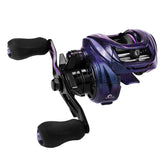
The Three Common Fishing Reel Types
Fishing reels are one of the most critical pieces of fishing gear. Without a reel, anglers have no way to retrieve or store lines. Adjustable drag, ball-bearing spools, and gears all contribute to making modern fishing reels effortless pieces of fishing tackle. The improvement in technology spawned multiple styles of fishing reels. While there are a number of different styles of reels, the three most prevalent types are spincast, spinning, and baitcasting. Each of these three reel types is varied enough to warrant its own article. However, we are going to cover the basics of them instead. To give angles a general knowledge to compare different reels, we will give a general overview of the reel, its advantages, disadvantages, and where it’s best used.
The Spincast Reel
The spincast reel is the most prevalent reel for beginners. The line is contained inside the reel and uses a push button to open the bail. The push-button system doesn't require finesse or a certain amount of pressure like the bails of the other reel styles. To use the push button, the angler engages the button, shaped like a peddle or flat trigger, on the top of the reel with their thumb. The reel will make an audible click, and when the button is released, the bail will be open until the reel is engaged and the angler begins cranking. One-handed casting is a synch with a spincast reel, and the simple controls extend beyond the bail. The spincast’s drag is a wheel that can be quickly adjusted and located on the top of the reel so anglers can see how far the drag is tightened. Spincast reels do well for small fish like panfish, trout, and even small catfish. Their retrieve speeds and drag are not as robust as the other reels, so their use is relegated to smaller-sized fish. The KastKing Cadet is a perfect example of a reel designed to be as hassle free as possible. Unlike other reels this one even comes prespooled so anglers can get to fishing even faster.

The Spinning Reel
The spinning reel is different from the other reel styles in the article as it sits under the rod as opposed to on top of it. Because of the position of the spool on the reel, the eyes of spinning rods must be larger to accommodate the line leaving the reel. Unlike the spincaster, the wire bail of a spinning reel must be manually flipped and the line held against the rod to keep it from unspooling. While the technique does take practice. The open spool of the spinning reel allows anglers to cast light lures serious distances. With a middle-of-the-road cost and great versatility, many anglers find the spinning reel the best bet for everything from casting spoons for trout to live-lining mackerel for tuna. That said, the spinning reel does have some drawbacks. The spinner's performance suffers when casting heavy lures or using heavy lines. The drag and gear ratios aren't ideal for long, tough fights when attempting to crank these heavy lures and heavier fish in. The Spartacus II spinning reel has the speed and capacity to properly fish lures from rooster tails to soft bodied frogs.

The Baitcasting Reel
The third style of fishing reel we are covering is the baitcasting reel. Despite its name, most anglers choose to fish artificial baits instead of "bait," like shiners or worms. The baitcaster has a spool running horizontally to the rod instead of vertically. There are several bonuses to the baitcaster’s spool setup. The first is power. The line can slip off the spool with a spinning reel when fishing heavy jigs or trying to hoist a big fish out of cover. A slipping line won't happen with a bait caster. The spool and handle placement also means that baitcasters can have a much more sensitive drag that anglers can adjust on the fly. Bait casters also have very high gear ratios that translate into fast retrieve speeds which is a big advantage when fishing swimming lures or jigs. A great example of this high speed ratio is KastKing Verus Assassin with a blistering 8.1:1 ratio. Fast enough to get a crankbait to the bottom, or a bass to the boat.

Three different reel styles cover a majority of fishing reels an angler will encounter. As we discussed, anglers can find the right reel style for the fishing they often plan on doing. For a casual day of teaching new anglers, it's hard to beat the spincast. For anglers looking to fish a variety of lures and baits for bass, the spinning reel is a jack of all trades reel. For the angler looking to throw big lures for musky or pitch a jig to big bass, the powerful baitcaster is the best tool for the job. When selecting a reel, remember that the only wrong choice is not going fishing.












